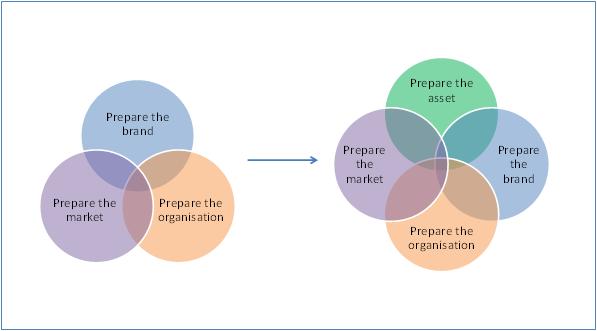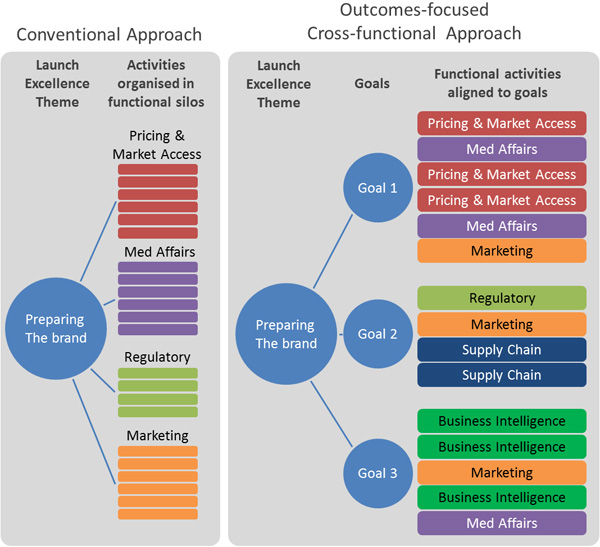Getting it right first time – planning for launch success

The future success of a product is typically determined by the trajectory of the first couple of months after launch. Launch excellence models often revolve around the three dimensions of preparation of the market, the brand and the organisation, with readiness activities typically ordered by function in neat Gantt charts.
Steve Mather looks at how a fourth dimension will impact launch excellence earlier, and how an outcomes-focussed rather than functional approach can engage cross-functional teams in making a successful launch happen.
This article draws on broad experience of supporting companies in early development decision-making and launch excellence.
We have all seen the impressive graphs indicating that the long-term success of a brand is determined by the performance trajectory of the first six, and some analyses showing, three months. Yet, despite the pharma industry taking a more commercially astute approach to development of new molecules, we see many products with little to differentiate them approaching the market, aimed at needs that are well satisfied, often in a rush to have some share of a burgeoning market – some entrants in the diabetes market being classic examples.
A product for which the necessary foresight has not been applied, arriving through phase 3 studies with little to differentiate it leaves those responsible for marketing and access struggling to find a place to succeed. Endpoints may be aimed only at needs that are already well satisfied, without the necessary demonstration of value over existing benchmarks. Marketers are left with the awkward position of having to deflate high internal expectations with the realities of low reimbursement and uptake probabilities, and in the worst cases, forecasts do not deliver a return. Organisations can unhealthily invest resource trying to make such a product succeed, when energy would be better spent elsewhere.
"Endpoints may be aimed only at needs that are already well satisfied, without the necessary demonstration of value over existing benchmarks."
As a global marketer, I had the interesting challenge literally screamed at me one day from the highest level in R&D "Our job is to develop drugs, your job is to get them reimbursed!" Think for a minute about everything that is wrong with that statement...
Hence my call for a fourth dimension to the typical three "rings" of launch excellence. A huge amount of money is invested in the two or three years run-up to launch on preparing the brand, preparing the market and preparing the organisation. A fraction of that money invested in foresight several years earlier to prepare the asset will go a long way to avoiding the above scenario.

Preparing the asset is about investing early and in enough depth to create foresight to develop robust strategy, driving development decisions through the sharp focus of a commercial lens. Before a single phase 2 study is drafted, companies need to determine the value proposition they are aiming at.
This requires a landscaping approach that goes beyond just finding unmet needs. An unmet need will stay unmet if a payer does not consider that meeting that need is worth paying for... Questions that need to be asked and answered include: Where are the most attractive and accessible opportunities? What will treatment pathways look like in 8–10 years' time? What will be the nature of the competitive environment? How will payers judge value? What will it take to win? And winning is not just in determining a competitive product profile. It is also about understanding the resource and capabilities that will be required organisationally, once the product is market-ready.
The conundrum is in balancing the risk of investing resource early, when a product has so many hurdles to jump before it reaches the market, with the risk of delivering an asset to the commercial team that is not best equipped to win. I would argue that investing in preparing the asset through early commercialisation strategising is money well spent. Be brave and bold about spending even a fraction of the overall development cost, direct that resource where it will make the most difference, and set your launch trajectory from phase 2. The development pathway defines what your product will be. If it doesn't deliver anything different and of value then your marketers and country teams face a tough struggle.
So, let's consider that we have prepared our asset, carefully navigating our future landscape, investing in the foresight needed to determine what it will take to succeed, and we have a winning asset coming through development.
How do we then best deliver launch readiness?
Let me answer this by challenging the standard convention of launch excellence.
Driving an organisation through launch preparation by functionally determined and functionally distinct Gantt charts is a successful model. Yet all too often we see teams working in functional silos, with not enough consideration of other roles and contributions and therefore lacking the cohesive cross-functional working required in the complexity of a product launch.
"The development pathway defines what your product will be. If it doesn't deliver anything different and of value then your marketers and country teams face a tough struggle..."
Contrast this with an outcomes driven approach to launch excellence, where all activities are driven by the goals that have been determined for success, where each function's contribution is towards achieving that goal. Where the consideration of what we are trying to achieve informs the preparation of the brand, the market and the organisation. This helps determine the activities needed to achieve our goals, aligning the plans and functional responsibilities with that in a cross-functional, goal focussed structure.

The approach begins well in advance of launch by engaging senior management in direction, goal setting and prioritisation of resource, and the cross-functional team in determining how it will get there. The plan itself becomes a tool to foster cross-functional collaboration in that it provides the framework, direction and guidance, where everyone knows what their colleagues are supposed to be doing, not just knowing what their own department needs to deliver. It is connected and not just task driven.
Companies that set the bar for launch success will be those that have a strategically prepared asset that is then managed in an effective cross-functional approach to launch excellence where people across the organisation, as a team, are pulling together to get it right first time.
About the author:
Steve Mather is a Partner at The MSI Consultancy – a Cello Health Company. He can be contacted at smather@msi.co.uk
Steve has worked for over 25 years in a number of senior Sales and Marketing executive roles across the pharmaceutical sector , both in affiliates and headquarters for companies including Serono, RPR and Sanofi.
He has led teams in global strategic and local operational roles and has a wealth of experience of leading multi-country projects translating global strategy into local plans.
Steve's particular areas of expertise are operational business management, commercial modelling and leading organisational change, and development and implementation of marketing, market access and sales force strategy.
Closing thought: What does it take to achieve launch excellence?












